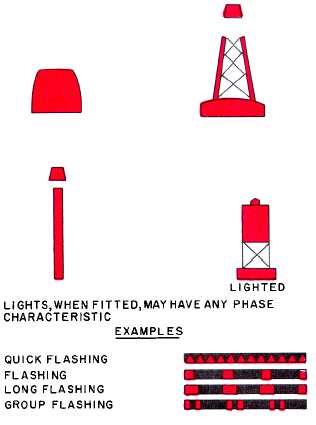| |
and port lateral marks. Yellow lights are for special
marks, and white lights are used for other types of
marks, which will be discussed later in this chapter.
PHASE CHARACTERISTICS.— Lights, when
fitted, may have any of the following phase
characteristics (or frequency of duration): quick
flashing, flashing, long flashing, or group flashing.
Lateral Marks
Lateral marks are generally used for well-defined
channels. They indicate the route to be followed and are
used in conjunction with a “conventional direction of
buoyage.” This direction is defined in one of two ways:
Local direction of buoyage—the direction taken
by the mariner when approaching a harbor, river estuary,
or other waterway from seaward.
General direction of buoyage—in other areas, a
direction determined by the buoyage authorities,
following a clockwise direction around continental
landmasses, given in Sailing Directions, and, if
necessary, indicated on charts by a symbol.
The numbering or lettering of buoys is an optional
feature. In the United States, fairway and channel buoys
are always numbered odd to port and even to starboard,
approaching from seaward. Table 5-3 shows the aids
used by the United States.
REGION A.— As shown in figure 5-19, Inter-
national Buoyage Region A covers Europe and Asia
with the exception of Japan, the Republic of Korea, and
the Republic of the Philippines. The major rule to
remember in this region is red to port when returning
from seaward. The lateral marks (buoys) used in Region
A are as follows:
Port-hand marks (fig. 5-21)
Color: Red
Shape (buoys): Can, pillar, or spar
Topmark (when required): Single red can
Light (when fitted):
Color: Red
Phase Characteristics: Any other than Composite
Group Flashing (2 + 1)
Starboard-hand marks (fig. 5-22)
Color: Green
Shape (buoys): Nun, pillar, or spar
C69.214
Figure 5-21.–IALA Maritime Buoyage System, International
Buoyage Region A port-hand marks (buoys).
Topmark (when required): Single green cone,
point upward
Light (when fitted):
Color: Green
Phase Characteristics: Any other than Composite
Group Flashing (2 + 1)
When the ship is proceeding in the conventional
direction of buoyage, a preferred channel may be
indicated by a modified port or starboard lateral mark at
the point where a channel divides.
Preferred channel to port (fig. 5-23)
Color: Green with one broad red horizontal band
Shape (buoys): Nun, pillar, or spar
Topmark (when required): Single green cone,
point upward
Light (when fitted):
Color: Green
Phase Characteristics: Composite Group Flashing
(2 + 1)
5-28
|

